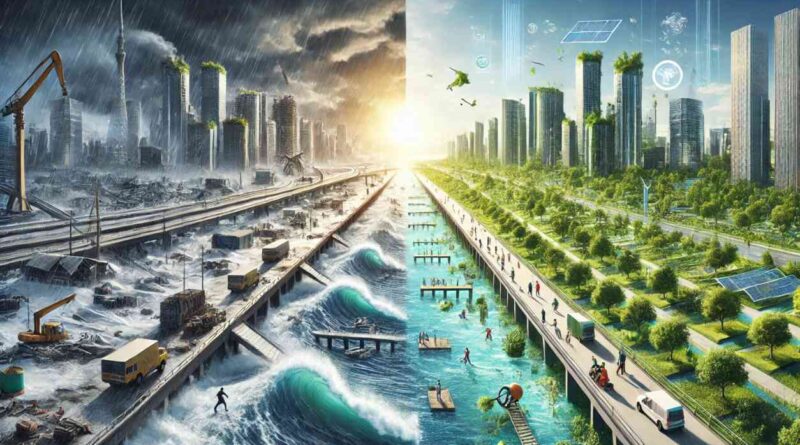Climate Risk and Resilience – Building a Stronger Future
In the face of climate change, the risks are no longer hypothetical or far-off—they are here, and they are real. From devastating floods and heatwaves to wildfires ravaging entire communities, climate change is impacting every corner of the globe. In response to this growing threat, climate risk and climate resilience have become crucial concepts for individuals, businesses, and governments alike.
Understanding these terms is not only vital for managing risk but also for ensuring a thriving, adaptive world in the future.
What Is Climate Risk?
Climate risk refers to the potential negative impacts of climate change on human systems and the environment. These risks are generally categorized into two types:
1. Physical Risks
These are direct risks caused by climate-related events, such as:
- Floods and hurricanes
- Wildfires
- Rising sea levels
- Extreme heat
These events can destroy infrastructure, disrupt supply chains, and severely affect agriculture and livelihoods.
2. Transition Risks
These arise as society shifts toward a low-carbon economy. Transition risks include:
- Policy changes (such as carbon taxes)
- The rapid adoption of new technologies (e.g., renewable energy)
- Market shifts, where investors and consumers increasingly favor sustainable, low-carbon options
Together, both physical and transition risks demand significant shifts in how we think about development, policy, and business operations.
What Is Climate Resilience?
Climate resilience refers to the capacity to anticipate, prepare for, and recover from the impacts of climate change. However, it’s not just about bouncing back—it’s about bouncing forward.
Building resilience means:
- Fortifying infrastructure to withstand extreme weather events
- Adapting agricultural practices to unpredictable climates
- Strengthening policies that protect vulnerable populations before disaster strikes
Ultimately, climate resilience is about proactive adaptation—taking action today to minimize future risks and losses.
Why Resilience Matters
In today’s world, resilience isn’t a luxury—it’s a necessity. Here’s why:
- Bangladesh has developed community-based shelters and early warning systems that have saved thousands during cyclones.
- The Netherlands employs state-of-the-art water management systems to protect its cities from rising sea levels.
- California has enacted fire-resistant construction codes to mitigate wildfire risks.
These examples illustrate that waiting until after disaster strikes is no longer an option. Resilience must be embedded in planning, policy, and business strategy.
Key Elements of Building Climate Resilience
To effectively build resilience, several key elements need to be addressed:
1. Risk Identification
Understanding risks is the first step. Mapping vulnerable regions helps stakeholders know where to focus efforts.
2. Infrastructure Upgrades
Existing infrastructure must be climate-proofed to handle the new normal of rising temperatures, flooding, and severe storms.
3. Ecosystem Restoration
Natural buffers—such as wetlands, mangroves, and forests—absorb shock from climate events. Their restoration is crucial for long-term resilience.
4. Community Involvement
Local knowledge is invaluable. Engaging communities in resilience efforts ensures that solutions are relevant and sustainable.
5. Financial Tools
Innovative tools like parametric insurance and climate bonds offer rapid funding for recovery efforts and help communities access financial resources when they need them most.
Climate Risk for Businesses
For businesses, climate risk is an urgent concern:
- Supply chains are vulnerable to extreme weather.
- Investors are demanding clearer climate-related disclosures.
- Regulations are increasingly pushing for sustainability.
- Consumers prefer brands with ethical and sustainable practices.
Building climate resilience into business strategies isn’t just about corporate responsibility—it’s about mitigating future risks and protecting investments.
Equity in Resilience
Climate change doesn’t affect everyone equally. Vulnerable populations—especially those in low-income regions, women, and children—are disproportionately impacted. Building resilience requires equity:
- Ensuring equal access to information and technology
- Involving marginalized communities in planning and decision-making
- Designing solutions that consider social and economic realities
True resilience is both climate-smart and equitable.
Want to Learn More?
If you’re interested in understanding how to manage climate risk and build resilience, we invite you to explore our 3-hour self-paced online course on Climate Risk and Resilience. This course is designed to provide you with:
- A deeper understanding of climate risk and resilience strategies
- Tools for effective policy development and climate adaptation
- Real-world case studies from countries taking the lead on resilience efforts




